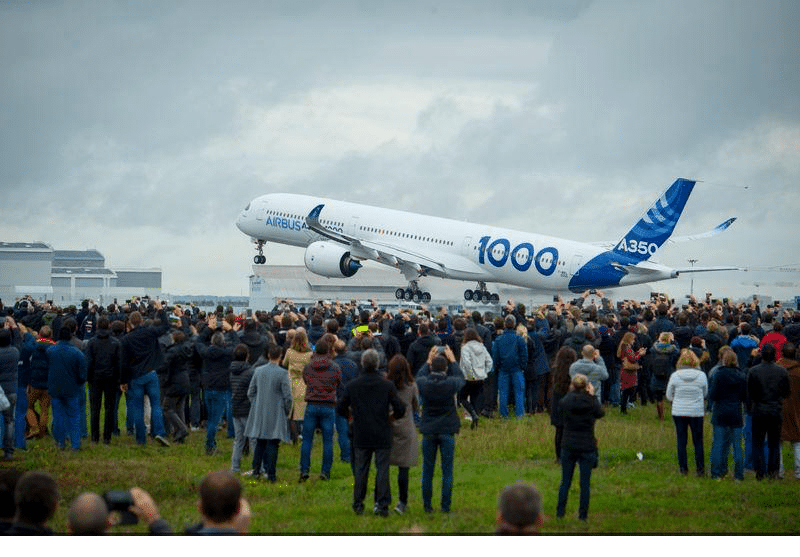
Airbus A350-100 first flight. Photo: Airbus.
Among the biggest news coming out of the annual Airbus press conference on Wednesday Feb. 22, being the company’s ongoing challenges with the A400M and A320neo engine, the company’s top executives also briefly discussed the company’s ongoing digital transformation. On everything from improving manufacturing and information sharing processes to using new data acquisition technologies for aircraft predictive maintenance, Airbus is focused on making its company and customers more connected.
In 2016, Airbus appointed Marc Fontaine as its first-ever digital transformation officer. The company’s website notes that Fontaine oversees more than 450 initiatives toward Airbus’ push toward digital offerings. Among these initiatives are those around improving aircraft flight operational data analytics processes, the use of more augmented reality technologies as well as robots for manufacturing processes.
“You can’t imagine what these new technologies, especially the digital technologies, bring to operations,” Fabrice Bregier, Airbus’ chief operating officer said during the company’s annual press conference Wednesday.
The way Airbus describes its transition to a fully digital aircraft platform is to break the traditional functional systems and data silos that have previously existed within commercial flight operations and move toward functional systems with the concept of a data lake. Airbus describes this concept of a data lake, as building a reservoir of data for each in-service aircraft, which is maintained for the entire lifecycle of the aircraft. That data reservoir would then be made available to relevant users across the company, for example an engineer that wants to see the lifecycle performance of an individual component so they can improve upon the design going forward. The company also wants to develop program specific analytics apps for each of its major aircraft types.
One of the more recent examples of its ongoing efforts was Airbus’ announcement of JetBlue as the launch customer of the first module of its “Scheduled Maintenance Optimizer” platform. The first module of this new tool focuses on long-term planning and features algorithms that allow JetBlue’s technical operations team to compute the most optimum maintenance schedules for its fleet of more than 200 aircraft over a five-year period.
Airbus is also still looking at ways to optimize predictive maintenance on the A350 XWB, which first entered service in 2015, and features 50,000 onboard sensors capable of collecting 250 gigabytes of data per flight.
The maintenance optimizer tool is part of the “Services by Airbus” offering, which features flight hour and tailored support packages; upgrades; training; e-solutions, engineering and maintenance; flight operations; air traffic management; and material management service. Similar to what Boeing’s CEO repeatedly stated during the company’s January annual press conference about growing its aftermarket service offerings, Bregier says this is one area he is focused on improving for Airbus. More than 200 airlines are already using Airbus’ “Smarter Fleet” technology.
Furthermore, Airbus demonstrated using a consumer drone for routine aircraft visual inspection. To do so, the drone followed a predetermined flight path and took a series of pictures automatically. Images of aircraft scratches, dents and other defects were then compiled in a three-dimensional digital model, recorded in a database and analyzed. The company notes that doing this using a drone takes 10 to 15 minutes, instead of the two hours required by conventional methods.
“From the design, how we can develop faster….using digital data and then later on when we capture the data of the aircraft in service offering better service to our customers, going closer to predictive maintenance and connected services,” Bregier said during the press conference.
Airbus’ single-aisle and long-range aircraft will also be going digital, as the result of a contract signed last year. The contract calls for supplying A320 and A330 aircraft with Cobham Satcom’s Aviator S-series satellite data units. The company will begin to install hardware on the two aircraft families starting in 2018.
The Aviator S-series technology is designed to enable pilots to share realtime, relevant information with dispatchers and ground control for greater safety, situational awareness and route optimization, and to sync aircraft directly with flight operations quality control systems.
The company will also continue to leverage its existing partnership with IBM, which was first announced in 2013, with a focus on providing operators with advanced IT services for maintenance, engineering and flight operations.
In 2017, Airbus plans to deliver more than 700 aircraft, compared to 688 in 2016.